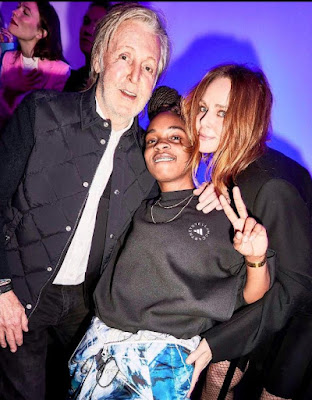By Laura Medina
"We’ve done a pilot in Turkey and got the regenerative cotton on the runway this season — I think we’re the only people to have it on the runway so far. We have the AlgiKnit, yarn made from algae, which is an amazing project, so we’re trying to R&D that at Stella. A lot of people investing in sustainability don’t have a product they need to source in a better way. But I’m in a very unique place, where I’m able to really test and design using different materials, like the mycelium [fungi]. It took such a long time to get the Mylo leather into a position where it could fold and not crack. When I can incubate a material and get it to a quality where I can use it as a luxury fashion house, then I can take it to my business partner, Mr. [Bernard] Arnault, and truly put it into production to swap out an existing old-fashioned business with, hopefully, the future of fashion. It’s about creating awareness and also actually changing a supply chain."
"The reason I wanted to start the fund with my colleagues was to have a meaningful impact on the industry. The SOS fund is sustainable solutions, and I feel that’s more and more my job than actually creating a fabulous jumpsuit. I’ve been doing this my entire career, and we’ve kind of been the pilot program for the industry, and there are no real incentives, financially. In fact, we’re kind of penalized for what we do. We have a vegan leather that basically takes the waste of the wine industry and uses the skins from the grapes and we make all of these incredible faux leathers. But when we bring them into America, we get hit with a 30 percent taxation! It’s shocking. I’ve been telling people that for 20 years and it’s still the case. I said to my team the other day, “Let me know how much money we’ve lost as a business.” Because how do you incentivize young businesses or smaller businesses to actually work in this way? You’re just completely demoralized in doing the right thing. My big hopeful impact before I leave Planet Earth is to try and bring young, exciting, new business models that use technology or a cleaner way of working into many industries."
"One hundred is not impossible. For me, it’s the only way. It’s the thing that I’m trying to get to. I don’t think any other brand in the world would even publish the numbers, because they wouldn’t even think to measure. It costs us not only money, but also time, to figure out that number. That’s not a small feat. You’ve got to go back to every single transparent supply chain and do the math. That’s not easy. And then you’ve got to look at what gets into the show, what was on the runway, and look at that number. I’m so proud of my company. It’s not me; it’s my team’s united desire to truly make a meaningful change in the industry."
"Some fabrics just don’t exist right now. Some things you can’t source. You’re very limited creatively. Sequins, for example, are all PVC so they have petroleum in them. Every sequin that you see in the world is plastic. We have a non-PVC rule, so we cut off our nose to spite our face. And so then I’ve got ten sequins I can use in five colors. But I’m a plant-based brand. We don’t have any leather or any glue. Even my bag here has aluminum chains, so they can be recycled, because metals aren’t so friendly. This is a faux leather, so I have two colorways, because they just don’t have the scale, the methods. If you want to do natural dyes and use vegetable oil coating, it is super complex. At the end of the day, at Stella McCartney, we are like the first people going to the moon in fashion."
"We had lead-free crystals on that and the viscose is forest-friendly. Two hundred million trees are cut down in a year just for rayon. And they’re not replanted, which is crazy. When I ask people in my industry, “Do you know what rayon is made of?” They’re like, “Plastic?” Nobody knows, which is nobody’s fault. At Stella we ask the questions and we find the solutions. We took three years of our time, and didn’t get any funding, to go and find a sustainable forest in Sweden, which cut down but replanted the trees, to create the viscose used on Adele’s dress."











No comments:
Post a Comment